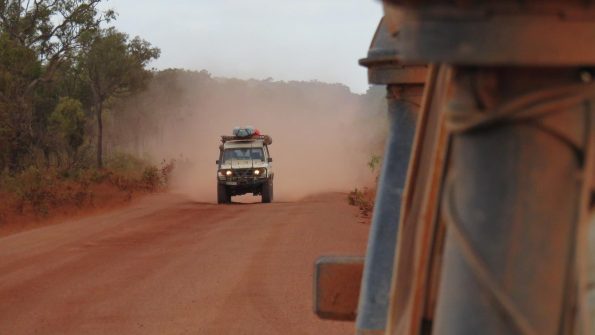Whether you’re heading inland in Australia or you’re going overseas to Africa, the Middle East or parts of the American West, you’ll find deserts you can drive through that have spectacular scenery but also spectacular risks – they don’t call it Death Valley because it’s all kittens and cold beer.
Communications
A cellphone charging cable for your car is essential in case you get stranded. You can get ones that fit into the cigarette lighter or auxiliary power socket if you don’t have a USB socket.
Make sure you’ve told someone where you are going and what time you’re expecting to arrive. They should know how to raise an alarm if you don’t touch base with them before a certain time.
Preparing the vehicle for the journey

If you want to be safe you need all the gear to be prepared for any eventuality.
Everything runs much hotter in the desert and your cooling system will struggle to keep up when the ambient temperature is 40 degrees. Parts of the car can fail much more quickly and with less warning than in temperate areas.
Your tyres should be inflated to the recommended temperature, including the space saver. If they are under-inflated they will heat up more quickly and that leads to degradation and risk of the tyre failing.
Check all your fluids – the coolant level and battery level (if it’s not a maintenance-free one) are important. Take a bottle of radiator sealant. Check your belts and hoses to make sure they are not cracked. Take at least five litres of water in case you have a radiator issue.
Take a sun visor for the windscreen to help keep the interior cooler when you are parked.
A tarpaulin can be useful for covering creating shade.
Preparing yourself for the journey
Don’t scrimp on water. Make sure you’ve taken enough food. Don’t drive tired. If you are riding a motorbike, the right protective clothing to shield you from the road but prevent you from overheating is essential. Night-time temperatures in the desert can plummet to not far above freezing, so take blankets.
On the journey
Fill up whenever you can as petrol stations can be few and far between. Give your vehicle (and yourself) a rest every so often to let the tyres and engine cool down.
If you can park in the shade, do so. If you can’t, be really careful about touching your vehicle. Even the metal bodyshell can absorb so much heat that it will burn your skin. This applies to the seatbelt buckle, the outside door handle and the steering wheel, too.
Don’t leave kids or pets in a parked car, no matter how cool it is at the time. The interior can heat up to more than 65 degrees Celsius in a matter of minutes, even with the windows open slightly.
If you are driving off-road, you will need much more in the way of supplies, a vehicle capable of handling the terrain and some additional vehicle control skills for when the going gets slippery or soft. Stay out of other vehicles’ dust plumes, be careful when driving through water, watch out for cattle grids, approach slopes straight on and understand how to adjust your tyre pressures to cope with different surfaces.
Watch for the weather
Hot weather can cause tar bleed which is where melted tar forms a slick surface. It’s particularly dangerous for motorcyclists on corners.
Dust storms can seriously reduce visibility. It’s best to stop with your hazard lights on and stay in the car with your seatbelt buckled until they pass but if you can’t stop, slow down until you can stop in the distance you can see ahead of you and use either the centre line or side line to judge your position. Your lights should be on. Continuing to drive through a dust storm will draw a lot of dust into the engine.
Rainstorms after a long period of dry weather will cause the road to lose 50% of its grip, making it very treacherous on the corners for the first 15-30 minutes after the rain starts, until the surface layer of grime and oil are washed away. Heavy rain in dry areas can often create flash floods if the ground is hard-packed and won’t absorb the water. Driving through a flood is not advisable.
If you break down
Pull over to the side of the road and open your bonnet and boot to indicate you need help. If your cellphone works, call for help. If it doesn’t work, don’t leave the car unless you can see a house within a few minutes’ walking distance; if you are going to that house, leave a written note on your car’s windscreen for rescuers. You can quickly become dehydrated and disorientated in the desert. It’s much easier for rescuers to see a disabled vehicle rather than a pedestrian in the distance. Instead of leaving the car, sit or lie in the shade. This might mean lying under the car. Ration your water. If the road is well-used, you should be able to flag down a passing motorist fairly soon, but if it’s remote, you can build a HELP sign in stones across the road.
